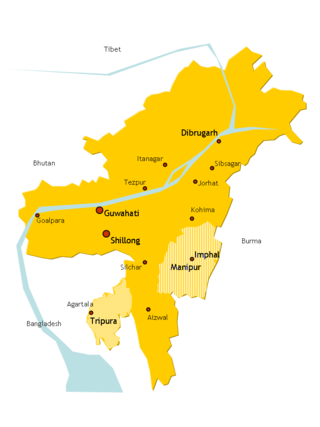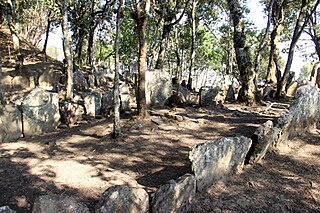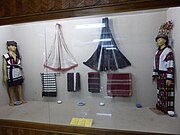
Mizoram is a state in northeastern India, with Aizawl as its seat of government and largest city. Within India's northeast region, it is the southernmost state, sharing borders with three of the Seven Sister States, namely Tripura, Assam and Manipur, and also shares a 722-kilometre (449 mi) border with the neighbouring countries of Bangladesh and Myanmar. The state spans over an area of approximately 21,087 square kilometres, of which approximately 91% is forested. With an estimated population of 1.25 million in 2023, it is the second least populous state in the country.

The history of Mizoram encompasses the history of Mizoram which lies in the southernmost part of northeast India. It is a conglomerate history of several ethnic groups of Chin people who migrated from Chin State of Burma. But information of their patterns of westward migration are based on oral history and archaeological inferences, hence nothing definite can be said. The recorded history started relatively recently around the mid-19th century when the adjoining regions were occupied by the British monarchy. Following religious, political and cultural revolutions in the mid-20th century majority of the people agglomerated into a super tribe, Mizo. Hence the officially recognised settlement of the Mizos became Mizoram.

Mizoram University is a central university established on 2 July 2001, by the Mizoram University Act (2000) of the Parliament of India. The President of India is the official Visitor, and the Governor of Mizoram acts as the Chief Rector as per Mizoram University (Amendment) Bill, 2007.
Pachhunga University College (PUC) is a public institute in Aizawl, Mizoram, and the only constituent college of Mizoram University, a central university established by an Act of Parliament of India. Founded in 1958 as Aijal College, it is the oldest and largest college in Mizoram, by enrolment and campus size. It started with intermediate of arts courses, and later expanded to bachelor's degrees in arts, commerce and science. With the opening of master's degree courses in Mizo, philosophy and life sciences, it became the first postgraduate college in Mizoram.
The Government Champhai College is a government university college associated with Mizoram University, located in Champhai, Mizoram, in India. Established as a private college in 1971 by the philanthropists of Champhai town and neighboring villages, the founders' objective was providing collegiate education to the students of this remote hilly tribal town near the international border of India with Myanmar.

Pu Lal Thanhawla is an Indian politician and former Chief Minister of Mizoram, belonging to the Indian National Congress party. He holds the record for longest-serving Chief Minister of Mizoram, occupying the position for five terms: 1984 to 1986, 1989 to 1993, 1993 to 1998, 2008 to 2013, and 2013 to 2018. He served as President of the Mizoram Pradesh Congress Committee from 1973 to 2021. His electoral constituencies were Serchhip and Hrangturzo from where he successfully contested the Mizoram Legislative Assembly elections nine times, in 1978, 1979, 1984, 1987, 1989, 1993, 2003, 2008, and 2013.

The Mizo National Front uprising was a revolt against the government of India aimed at establishing a sovereign nation state for the Mizo people, which started on 28 February 1966. On 1 March 1966, the Mizo National Front (MNF) made a declaration of independence, after launching coordinated attacks on the Government offices and security forces post in different parts of the Mizo district in Assam. The government retaliated and recaptured all the places seized by the MNF by 25 March 1966.

Education in Mizoram consists of a diverse array of formal education systems ranging from elementary to university, from training institution to technical courses. The Government of India imposes mandatory education at least up to the basic level. For this public schools are made free of fees, and provided with free textbooks and school lunch.

Christianity is the largest religion in Mizoram. The majority 87% of Mizoram population are Christian in various denominations, predominantly Presbyterian. More than 98% of the Mizos are Christians by faith. The Government of Mizoram declared that Christianity plays a very important role among the daily life of Mizo community and therefore further declared that Christianity as the religion of the state. The culture of Mizoram is mainly influenced by Christianity. Hence, Christianity was given a special status on the state by the government while maintaining a minimum level of secular environment and approach. In June 2018, the government of Mizoram including Vanlalruata, president of anti-corruption organisation-turned-political party, People's Representation for Identity and Status of Mizoram claim that Mizoram is a Christian state. Hindus form a small minority (3.55%) mainly of Manipuris and there are also around (7.93%) Buddhists according to the 2001 census, mostly made up from Chakma settlers of Arakan origin. There are about 8,000 mostly ethnic Mizo followers of a Judaic group Bnei Menashe, who claim descent from the biblical Menasseh. Muslims make up about 1.1% of the state population.
Mary Winchester, or Zolûti to Mizos, (1865–1955) was a Scottish girl who was captured and held hostage by the Mizo tribes of Mizoram, India, in 1871, and rescued by the British expedition in 1872. This historic event marked the beginning of British rule in Mizoram that lasted until the Indian Independence in 1947. Indirectly, it also paved the way for Christian missionaries to introduce Christianity among the Mizos.

The history of Christianity in Mizoram covers the origin and development of all forms of Christianity in Mizoram since the British occupation at the end of the 19th century until Indian Independance. Christianity arrived due to British intervention in tribal warfare, raids of British plantations. The ensuing punitive British military expedition was called the Lushai Expedition of 1871. The subsequent annexation of the erstwhile Lushai Hills to the British Empire opened the gateway for British Christian missions to evangelise the Mizo people.

Chanmari Football Club is an Indian professional football club based in Aizawl, Mizoram. They are currently competing in Mizoram Premier League & I-League 3, the top level of football in the state of Mizoram. They had also participated in national level competition, 2015 I-League 2nd Division.

Mizoram is a state in the northeast of India. Mizoram is considered by many as a beautiful place due to its landscape and pleasant climate. There have been many attempts to increase revenue through tourism but many potential tourists find the lack of amenities to be a hurdle. However, the State continues to promote itself and many projects have been initiated. The tourism ministry continues to maintain or upgrade its tourist lodges throughout the state. Foreign tourists are required to obtain an 'inner line permit' under the special permit before visiting. The permit can be obtained from Indian missions abroad for a limited number of days or direct from Mizoram Government authorities within India. The state is rich in bird diversity, which has the potentiality to make it a major birding destination. Mizoram is a stronghold for Mrs. Hume's pheasant. There is also a rare record of the wild water buffalo from the state. There are several past records of the Sumatran rhinoceros from Mizoram, then Lushai Hills. The small population of wild elephants can be seen in Ngengpui and Dampa Sanctuaries.
Pahlira Sena Chawngthu (1922–2005) was a Mizo poet, singer, and radio broadcaster from the Indian state of Mizoram.

Laltluangliana Khiangte is a Mizo academic, playwright and poet of Mizo literature. He was the principal of the Serampore College and a former professor at Pachhunga University College and the North Eastern Hill University. He is presently serving as the senior most professor at the Department of Mizo at Mizoram University. He is a recipient of the Pu Buanga Award, the highest literary award of the Mizo Academy of Letters. The Government of India awarded him the fourth highest civilian honour of the Padma Shri, in 2006, for his contributions to Indian literature.
William Lalnunfela is an Indian professional footballer who plays as a forward for Kerala United in the I-League 3.

The following outline is provided as an overview of and topical guide to Mizoram:

The culture of the Mizo people has been heavily influenced by Christianity during the colonial era of the British Raj and the rise of Mizo nationalism with the Mizo Insurgency of 1966-1986. Mizo culture is rooted in the arts and ways of life of Mizos in India, Bangladesh and Myanmar. Mizo culture has developed in plurality with historical settlements and migrations starting from Southern China to the Shan states of Burma, the Kabaw valley and the state of Mizoram under the British and Indian administrations.
The Mizoram Peace Accord, 1986 was an official agreement between the Government of India and the Mizo National Front (MNF) to end insurgency and violence in Mizoram, India, that started in 1966. The Mizo National Front was an organisation of Mizo secessionists led by Laldenga to fight for independence from India. The movement was basically due to lack of support from the government during the great famine in Mizoram in the late 1950s. Political insurgency and social unrest ensued in the next decades. After a number of negotiations, the document titled Mizoram Accord, 1986: Memorandum of Settlement was finally signed on 30 June 1986. It was signed by Laldenga for MNF, R.D. Pradhan, Home Secretary, Government of India, and Lalkhama, Chief Secretary, Government of Mizoram. It is remarked as the most and only successful peace agreement in India after its independence from British Empire in 1947.

Aizawl, formerly known as Aijal, is the capital city and the most populous city of Mizoram, India. It is also the fourth largest city in northeast India, after Agartala and Imphal. It is situated atop a series of ridges, with an average elevation of around 1,132 metres above sea level. In 2024, the city has an estimated population of 405,000 people.




















